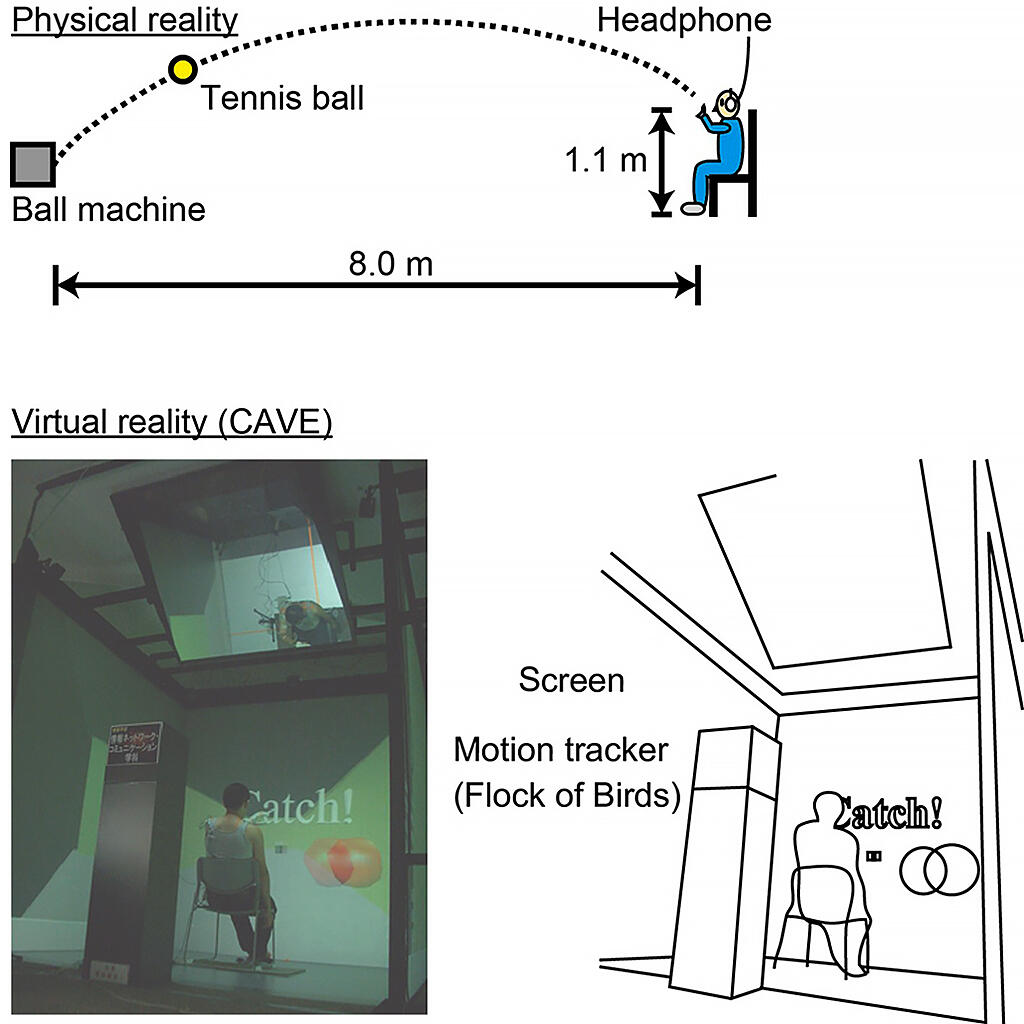Professor Hirofumi Ida of the Faculty of Business and Information Sciences, Jobu University, in collaboration with Assistant Professor Kazunobu Fukuhara of the Graduate School of Health Sciences, Tokyo Metropolitan University, and Assistant Professor Takahiro Ogata of the Faculty of Medical Technology, Teikyo University, announced that they have found that subjects' arms move differently when making a catching motion in a virtual reality (VR) space compared to the same action in physical reality. The researchers acquired these results by comparing catching behavior in physical reality in a laboratory and in a room-sized cubic VR system (CAVE) that simulated the real space in the laboratory. Subjects' arm lift speed, movement duration, and muscle activity timings also differed. These results are expected to lead to the development of effective methods for training and rehabilitation using VR. The results were published in the international scientific journal Frontiers in Sports and Active Living.

Provided by Jobu University and Kanagawa Institute of Technology
2016 was known as "the year of VR". Since then, a series of head-mounted displays (HMDs) have been developed for the consumer use, making VR a more familiar part of daily life. There are also high hopes for the application of VR in sports and rehabilitation. However, researchers do not yet fully know whether sports and rehabilitation training can be performed in a similar fashion in virtual reality.
In this study, the research group verified the difference between catching (a basic motor skill in ball sports) in physical reality and virtual reality using CAVE. CAVE is a VR system developed at the University of Illinois in the U.S. It produces a VR space through lightweight 3D glasses worn inside a box-shaped screen.
13 healthy adult males participated in the study. In the physical reality experiment, the participants caught a tennis ball projected by a ball machine. In the virtual reality experiment, two video conditions were set up: a flat (2D) presentation and a stereoscopic (3D) presentation where a virtual ball was sent for the participants to catch. Participants wore headphones that shut out ambient sound and 3D glasses, sat in a chair with their arms down, and were instructed to catch a ball flying slightly above their shoulders with one hand (non-dominant hand) while still seated.
Participants tried to catch the ball 20 times each, sent at three different speeds: slow, medium, and fast. The order of the speeds projected was changed for each participant. The CAVE space experiment's modeling parameters (ball size, trajectory, and velocity) were determined using actual measurements in the real space.
During each experiment, participants' shoulder flexion movements were measured using a goniometer (joint angle meter). In addition, surface electromyograms were recorded for the anterior deltoid (shoulder), biceps brachii (upper arm), and flexor carpi radialis (forearm). Data from physical reality and the CAVE virtual reality experiments were compared between individuals.
The results showed that catch rates similarly decreased as ball speed increased both in the physical reality and CAVE space experiments. However, analyses of shoulder flexion movements showed significantly slower movement speed and longer movement time in the CAVE virtual reality space compared to physical reality. Reaction time, measured using the surface electromyograms, revealed that the time from the start of muscle activities to the start of shoulder flexion was shorter in the 2D presentation condition in the CAVE virtual reality space than in physical reality and 3D presentation conditions.
These results indicate that VR differs from reality in terms of arm lifting motions, timing of muscle activity, and muscle activity level. Since the participants were performing the VR experiment after the real experiment, they likely did not intentionally change their movements, indicating that different motor performance is obtained in different environments. The weight of HMDs may also be an obstacle to reproducing the delicate movements of sports.
Ida commented, "We are currently engaged in research on standing balance using HMDs to apply VR to rehabilitation. We believe we can achieve appropriate performance by exploring what makes VR different from reality and the relationship between the two and building a system that reflects that relationship."
Journal Information
Publication: Frontiers in Sports and Active Living
Title: Virtual reality modulates the control of upper limb motion in one-handed ball catching
DOI: 10.3389/fspor.2022.926542
This article has been translated by JST with permission from The Science News Ltd.(https://sci-news.co.jp/). Unauthorized reproduction of the article and photographs is prohibited.




